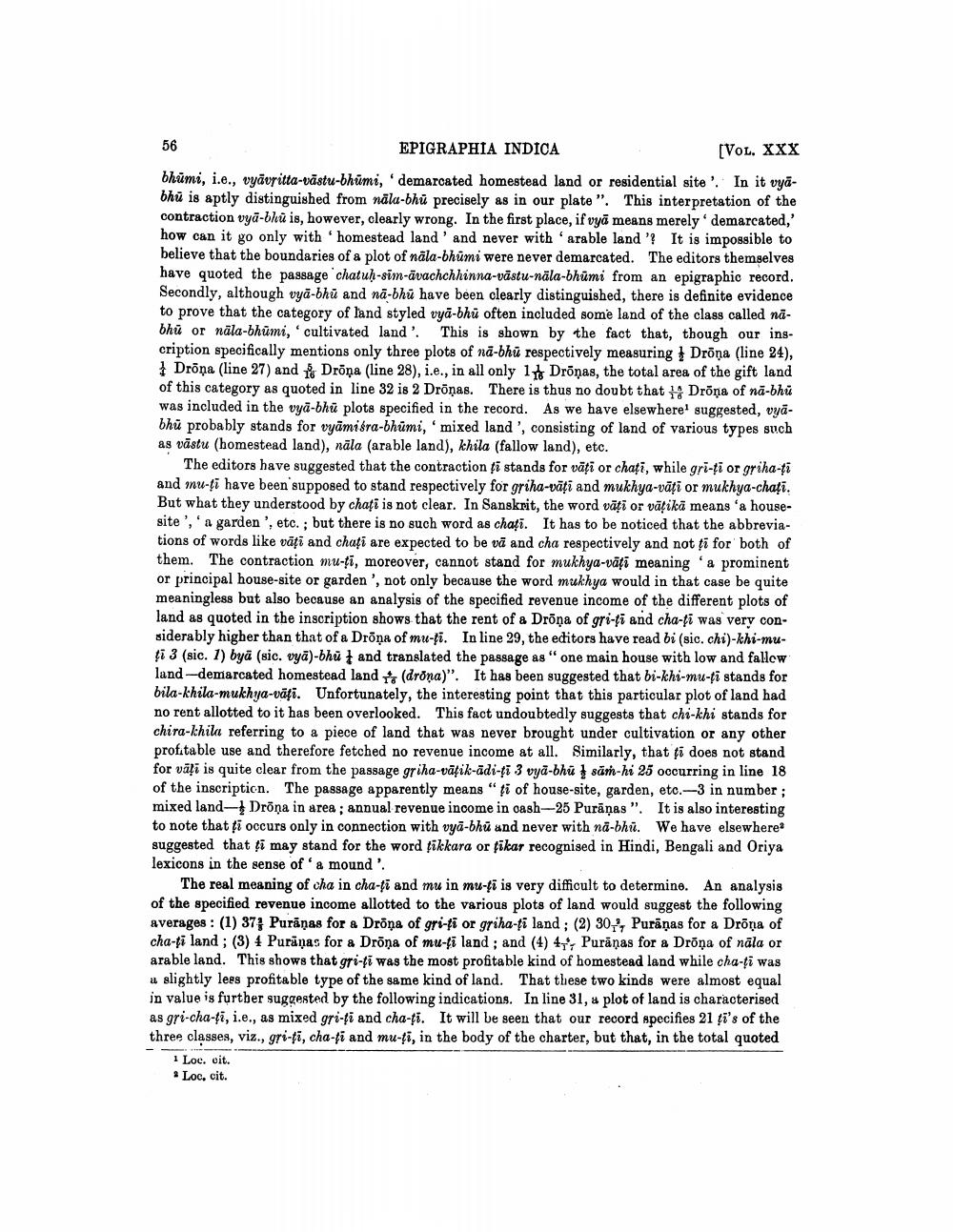________________
EPIGRAPHIA INDICA
[VOL. XXX bhumi, i.e., vyavritta-vastu-bhūmi, demarcated homestead land or residential site. In it vyabhu is aptly distinguished from nala-bhu precisely as in our plate". This interpretation of the contraction vya-bhu is, however, clearly wrong. In the first place, if vya means merely demarcated,' how can it go only with homestead land' and never with arable land? It is impossible to believe that the boundaries of a plot of nala-bhumi were never demarcated. The editors themselves have quoted the passage chatuḥ-sim-ävachchhinna-västu-näla-bhumi from an epigraphic record. Secondly, although vya-bhu and na-bhu have been clearly distinguished, there is definite evidence to prove that the category of land styled vya-bhu often included some land of the class called nābhū or nāla-bhūmi, cultivated land'. This is shown by the fact that, though our inscription specifically mentions only three plots of na-bhu respectively measuring Drōna (line 24), Drōna (line 27) and Drōna (line 28), i.e., in all only 1 Droņas, the total area of the gift land of this category as quoted in line 32 is 2 Drōņas. There is thus no doubt that Drona of na-bhu was included in the vya-bhū plots specified in the record. As we have elsewhere! suggested, vyabhu probably stands for vyamiśra-bhumi, mixed land', consisting of land of various types such as vastu (homestead land), nala (arable land), khila (fallow land), etc.
56
The editors have suggested that the contraction fi stands for vați or chați, while gri-ți or griha-ți and mu-ți have been supposed to stand respectively for griha-vāți and mukhya-văți or mukhya-chati. But what they understood by chați is not clear. In Sanskrit, the word vați or vātikā means 'a housesite, a garden', etc.; but there is no such word as chați. It has to be noticed that the abbreviations of words like vați and chați are expected to be va and cha respectively and not ti for both of them. The contraction mu-ți, moreover, cannot stand for mukhya-vați meaning a prominent or principal house-site or garden', not only because the word mukhya would in that case be quite meaningless but also because an analysis of the specified revenue income of the different plots of land as quoted in the inscription shows that the rent of a Drona of gri-ți and cha-ți was very considerably higher than that of a Drōna of mu-ti. In line 29, the editors have read bi (sic. chi)-khi-muți 3 (sic. 1) byä (sic. vya)-bhu and translated the passage as "one main house with low and fallow land-demarcated homestead land (drona)". It has been suggested that bi-khi-mu-ți stands for bila-khila-mukhya-väli. Unfortunately, the interesting point that this particular plot of land had no rent allotted to it has been overlooked. This fact undoubtedly suggests that chi-khi stands for chira-khila referring to a piece of land that was never brought under cultivation or any other profitable use and therefore fetched no revenue income at all. Similarly, that ti does not stand for vāți is quite clear from the passage griha-vātik-ādi-ți 3 vya-bhū sām-hi 25 occurring in line 18 of the inscription. The passage apparently means "ți of house-site, garden, etc.-3 in number; mixed land- Drōna in area; annual revenue income in cash-25 Purāņas". It is also interesting to note that ţi occurs only in connection with vya-bhu and never with na-bhu. We have elsewhere? suggested that i may stand for the word tikkara or fikar recognised in Hindi, Bengali and Oriya lexicons in the sense of a mound'.
The real meaning of cha in cha-ți and mu in mu-ți is very difficult to determine. An analysis of the specified revenue income allotted to the various plots of land would suggest the following averages: (1) 37 Purāņas for a Drōna of gri-ți or griha-ți land; (2) 30, Purāņas for a Drōna of cha-ți land; (3) 4 Puranas for a Drōna of mu-ți land; and (4) 4 Puranas for a Drōna of nāla or arable land. This shows that gri-ți was the most profitable kind of homestead land while cha-ți was a slightly less profitable type of the same kind of land. That these two kinds were almost equal in value is further suggested by the following indications. In line 31, a plot of land is characterised as gri-cha-ți, i.e., as mixed gri-ți and cha-ți. It will be seen that our record specifies 21 ti's of the three classes, viz., gri-ti, cha-ți and mu-ți, in the body of the charter, but that, in the total quoted
1 Loc. cit.
2 Loc. cit.




